Some of My Lives (17 page)
Authors: Rosamond Bernier

Interviewing James Rosenquist for a series I did for CBS (Photograph courtesy of CBS)
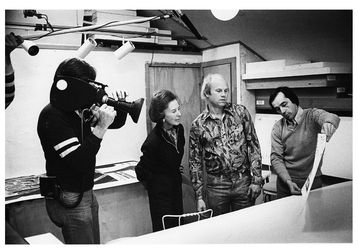
David Hockney's oversized card for my ninetieth birthday

Interviewing Henry Moore about Rodinâin the surf at Forte dei Marmi, 1967 (John Hedgecoe)

Braque in his studio, where I was interviewing him about his painting
L'atelier
, 1958 (Robert Doisneau for
House and Garden
)
L'atelier
, 1958 (Robert Doisneau for
House and Garden
)
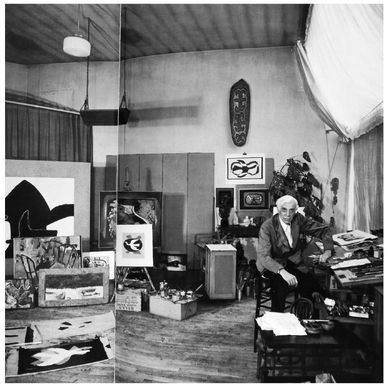
My photo of David Hockney in our New York apartment

Matisse in bed showing me his illustrated books, 1948 (© Clifford Coffin)
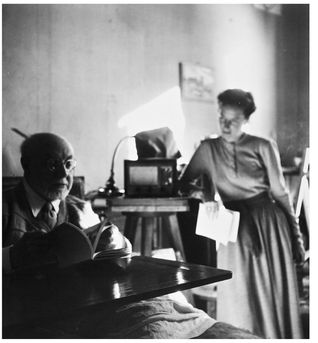
Our double portrait, a wedding present from Richard Avedon (Richard Avedon)
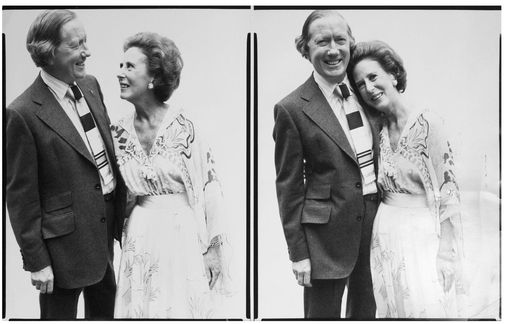
Our wedding at the Glass House, 1975. The fatal moment. (Iris Schneider)

John and his two granddaughters, Isabel and Chloe Grimshaw (Lavinia Grimshaw)

With John and his daughter, Lady Grimshaw, at the Spanish Institute after I was given a Spanish decoration
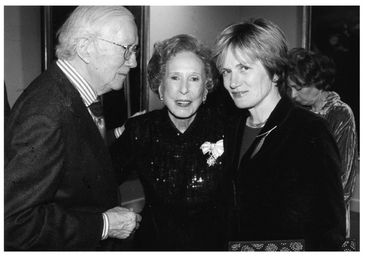
My stepson and best friend, Olivier Bernier

With my nieces Margarita and Natalia Jimenez at the Spanish reception

W
e made a point at the magazine of looking up survivors who could give us firsthand accounts of past notables. There was Henri-Pierre Roché reminiscing about playing golf with Constantin Brancusi; Jacques Salomon writing about his family, which included Edouard Vuillard; Francis Jourdain, who could say in print, “I knew Lautrec, Cézanne, Monet.”
e made a point at the magazine of looking up survivors who could give us firsthand accounts of past notables. There was Henri-Pierre Roché reminiscing about playing golf with Constantin Brancusi; Jacques Salomon writing about his family, which included Edouard Vuillard; Francis Jourdain, who could say in print, “I knew Lautrec, Cézanne, Monet.”
In 1959, I visited a distinguished old lady (then very much alive at eighty) who was the daughter of Berthe Morisot as well as Edouard Manet's niece: Madame Ernest Rouart. Berthe had married Manet's brother, Eugene. Julie Manet Rouart still lived in Paris in the house her parents built in 1883, on what used to be called the rue de Villejustânow renamed the rue Paul Valéry because the poet too lived in the same apartment building.
I climbed the five flights to her walk-up apartment (she didn't get puffed, I did) to find a lively upright figure, snow-white hair, with a remarkable memory. She lived surrounded by family mementos that happened to be by Renoir, her mother, Berthe Morisot, her uncle Ãdouard Manet, Edgar Degas, and Claude Monet.
There were pictures all over the placeâstacked several deep on the walls, leaning against easels, propped against the walls, over the chimneyâthe better to fight for their lives among the blue-and-white porcelains, the little flowers in pots, the family treasures accumulated over more than seventy years. A Delacroix watercolor perched under the famous portrait of Julie as a child holding a cat, by Renoir. Over the door, a decorative view of Bordighera that Monet painted especially for this salon. He said he had used pink tones to go with the cretonne on her walls, and if she didn't like it, she should just return it. She did like it.
And of course paintings by Berthe Morisot: portraits of Julie, her large luminous oil of girls picking cherries, her copies after Boucher and Veronese.
Julie told me that her mother as a young woman was very pretty and always elegant. When the fashion was for elaborate bustles, she ignored it. When other women wore little black boots with white dresses, she ignored that too. Even when she sprained her ankle, she went on wearing her favorite little pink silk slippers.
Berthe Morisot adored her only child and painted and drew her at every stage of her young life. Berthe was particularly fond of the Bois de Boulogne, which was near her house. Often its trees, its lake with ducks and swans, were the background for the paintings and sketches of little Julie's outings.
Incidentally, although now in the middle of Paris, in Julie's childhood the big garden was filled with fruit trees. Sometimes Mary Cassatt would come over on horseback from her ride in the Bois. She would lift up young Julie and take her for a canter.
One time when I went to visit Julie Manet, she showed me some of her mother's sketchbooks. They were full of rapid, evocative drawings, but we also came across, over and over again, the marks of a true French housewife. There were specimen menus. One consisted of
potage royal
, oysters, a stuffed turkey,
endives à la crème
, and a
bavaroise
. (One wonders how she stayed so slim on such a diet!) She loved to introduce her guests to unexpected dishesâMexican rice, for instance, or chicken with dates.
potage royal
, oysters, a stuffed turkey,
endives à la crème
, and a
bavaroise
. (One wonders how she stayed so slim on such a diet!) She loved to introduce her guests to unexpected dishesâMexican rice, for instance, or chicken with dates.
There were also lists of silverware: “eight sets of large knives, forks and spoons, one matching knife missing.”
As for the studio, I learned, it was often the extension of the drawing room or dining room or vice versa, whence many a quick change of décor resulted.
There were several of Manet's portraits of Berthe hanging in that extraordinary time capsule. I asked Julie Manet about them.
“Manet loved to paint my motherâin fact he made twelve portraits of her.” Berthe met Manet when she was working at the Louvre, making a copy after Rubens. She was twenty-seven years old. There was a great camaraderie among painters who worked in the Louvre, and as Berthe Morisot was clearly a young woman of good family, it was the most natural thing in the world for Manetâwho came from
a similar backgroundâto ask her and her mother to the house. Berthe was always chaperoned by her mother on such expeditions.
a similar backgroundâto ask her and her mother to the house. Berthe was always chaperoned by her mother on such expeditions.
Manet hoped to persuade her to pose. Eventually, she did (in 1868â69) for the painting called
The Balcony
.
The Balcony
.
I asked if I might come back with a photographer. The old lady smiled and said that reminded her of when Degas used to come to dinner with his prehistoric camera. “It was perfectly terrible,” she said. “There was no escaping it. Once dinner was over, we had to collect all the lamps and candles in the house (we had no electricity) and put them together under his direction. Degas would set up his camera, and we had to get in a happy heap and stay completely still. Four and a half minutes for each exposure, and we almost cried from the effort not to blink.”
Berthe Morisot never ran after famous men, her daughter told me. They came to her, as if magnetized. When she took landscape painting lessons from Corot, he couldn't see her often enough. It seemed that Corot was so highly thought of in the household that he was given a special dispensation to smoke his pipe after dinner.
When she wanted to buy a piano, it was Rossini, the master of the crescendo, who went with her to the store, told her which piano to get, and autographed it for her.
Puvis de Chavannes, not a household name today, was highly regarded as a painter and thinker in the Paris of his time. As a suitor, however, he lacked élan, but Berthe Morisot preferred him to Degas in that role.
“Degas pretended to make up to me,” she said once, “but he confined his courtship to a long commentary on Solomon's remark that woman is the desolation of the righteous.”
Even the furniture here had associations. “You see that Empire chaise longue over there, covered in red velvet? My mother used to rest there, near the little radiator where she warmed her feet. That is where Mallarmé stood when he read his paper on Villiers de L'Isle-Adam. My father admired this text very much and asked Mallarmé to come here to read it for a few special friends. Monet was there, he only came in from Giverny for special occasions. Renoir was over there by the small sofa, he was in full dress, he looked very handsome in tails. Degas was over there. A bit bad tempered that night. Usually, he did all the talking!”
Julie Manet remembered her parents talking about the drama of Morisot's double portrait of her mother and sister. It was an unusually hefty picture for Berthe Morisot: it showed her subjects sitting side by side. Behind them, Morisot opened up the slightly claustrophobic scene by putting in a picture within a picture that suggested a whole world outside.
But there was something about it that wasn't quite Morisotâsomething ponderous and motionless; duty and boredom were somewhere in the air.
When she asked her friend Puvis de Chavannes what he thought of it, he said her mother's head wouldn't do at all. She took it out and did it again. Could he come over and have another look? Alas, he couldn't, though he said the rest of it was perfectly all right.
The next day, in an agitated state, Morisot went to Manet and told him she had horrible doubts about the double portrait. Generosity itself, he said he would come over as soon as he got his own picture ready to dispatch to the Salon. “Put yourself in my hands,” he said. “I'll tell you what should be done.”
Sure enough, he came around the following day. What happened next is best told in Morisot's own words:
Manet came about one o'clock and said the painting was really very good, except for the lower part of the dress. He took my brushes and put in an accent or two that looked very well. Mother was in ecstasy. But there is where my misfortunes began. Once launched, there was no stopping him. From the skirt he went to the bust, from the bust to the head, from the head to the background. He cracked a thousand jokes, laughed like a maniac, handed me the palette, took it back. By five o'clock in the afternoon we were faced with the prettiest caricature you ever saw. The carter was waiting outside to take it to the Salon. Mother made me send it, whether I wanted to or not.
Now I don't know what to do. My only hope is that they will turn it down.
My mother thinks this is all very funny but to me it is agony.
Her mother wrote to her daughter Edma:
Berthe will have told you about the mishaps. Yesterday she looked as if she was going to faint. Her despair and discontent were so great that they could only be described as a morbid condition.
I made things worse by saying I thought Manet's “improvements” to my head were atrocious. When she kept telling me that she would rather drown herself in the river than have the picture accepted, I thought that I should ask for it to be sent back.
I got it back. But now we have a new problem. Won't Manet be offended? He spent the whole of a Sunday afternoon on the picture, making a pretty mess, and consigned it himself to the carter. I cannot tell him that it did not get there in time, since [Berthe's] little painting of Lorient went with it and he will see it.
As you know, even the smallest thing in this house takes on the dimensions of tragedy, because of our nervous and febrile disposition.
Ah me!
Berthe Morisot had always been frail, and the privations suffered during the Franco-Prussian War further weakened her. She died in 1895; she was only fifty-four. Her husband, Eugène Manet, had died a few years before.
This left sixteen-year-old Julie an orphan. Mallarmé was appointed her guardian. He wrote the text for Berthe Morisot's memorial retrospective exhibition. Thanks to Julie's diary, we know exactly what happened when Degas, Monet, Renoir, and Mallarmé joined forces to hang that exhibition: every one of them had his opinion, and every one of them stuck to it.
When I got to the gallery on Monday, March 2, Monsieur Monet was already there. He embraced me tenderly. And I was touched that he had come running to help us instead of getting on with his own work.
Monsieur Degas was also at work on the hanging, and Monsieur Renoir arrived soon afterward. He looked terrible. One of Monsieur Mallarmé's duties was to go and see the printers about the catalog.
Tuesday, March 3. Another full day at the gallery. The pictures look better and better. As there is more room than we had expected, we sent for Mama's copies after Boucher and Veronese.
Wednesday, March 4. We found Monsieur Degas all by himself, hanging the drawings in the room at the back. He keeps saying that he doesn't give a damn about the public, all those people who walk by pictures without really looking at them, saying isn't it beautiful. Beautiful!
By the end of the afternoon we wondered how we'd ever be ready for the following day and we agreed to meet again in the morning.
But we had to decide whether to put the big screen with the drawings and watercolors in the middle of the big room or in the smaller room at the back. Monsieur Degas is the only one who wants it in the big room, where it blocks the view and stops the visitor from standing back to see not only
The Cherry Tree Pickers
and the big Boucher copy but a lot of smaller pictures that harmonize so well when you see them from a distance and as an ensemble. But Monsieur Degas couldn't bear the word “ensemble.” “There is no such thing,” he said. “Only an imbecile talks that way.”
The Cherry Tree Pickers
and the big Boucher copy but a lot of smaller pictures that harmonize so well when you see them from a distance and as an ensemble. But Monsieur Degas couldn't bear the word “ensemble.” “There is no such thing,” he said. “Only an imbecile talks that way.”
Toward six o'clock it was getting so dark that only the oil paintings caught what was left of the light and the screen looked more and more like a wall that was in their way. Monsieur Monet asked Monsieur Degas if he would be kind enough, tomorrow, to try the effect of the screen in the smaller room at the back.
But Monsieur Degas swore that no one would see the drawings that were on the screen. “They are superb,” he said. “I like them as much as any of those paintings.” “But,” Monsieur Mallarmé said, “in the roomful of drawings the screen will make an effect of intimacy. Besides, if the public
sees drawings and paintings together, they won't know what to make of it.”
sees drawings and paintings together, they won't know what to make of it.”
“I don't care about the public,” said Monsieur Degas. “The public never sees anything anyway. We're making this exhibition for me, for ourselves, not for the public. Don't tell me that you want to teach the public to look at pictures.” “I don't agree,” said Monsieur Monet. “That's exactly what we should do. If we were making the show just for ourselves, there'd be no point in hanging them on the walls. They'd look just as well on the floor.”
During this discussion, Monsieur Renoir said that we really ought to put the pouf in the middle of the big room. I myself thought it might be rather nice to sit down and look. But Monsieur Degas wouldn't hear of it: “I'd stand on my feet for thirteen hours on end if I had to.”
By then it was quite dark, and Monsieur Degas was stamping back and forth in his tall hat and his heavy Inverness cape. His silhouette amused me very much. Monsieur Monet was still standing up and making a lot of noise. Monsieur Mallarmé reached out with his hand and tried to straighten things out in his gentlest voice. Monsieur Renoir was slumped in a chair, exhausted. The men from the gallery were laughing among themselves. “He'll never give up,” they said.
Other books
The Thirteenth Legion (A James Acton Thriller, #15) (James Acton Thrillers) by J. Robert Kennedy
Betrayed by Wodke Hawkinson
Blindsided (Indigo Love Spectrum) by Williams, Tammy
A Countess by Chance by Kate McKinley
Prairie Fire by Catherine Palmer
Fair Play by Tracy A. Ward
The Lost Books of the Odyssey by Zachary Mason
06 Love Bites - My Sister the Vampire by Sienna Mercer
Kiss of the Bees by J. A. Jance
